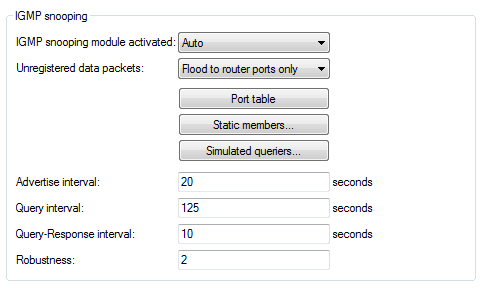The configuration of the IGMP snooping in LANconfig is located under

- IGMP snooping module activated
- Activates or deactivates IGMP snooping in the device and all of the defined querier instances. Without IGMP snooping the bridge functions like a simple switch and forwards all multicasts to all ports.
Possible values:
- Yes
- No
- Automatic
- Automatic
Note: If this function is deactivated, the bridge sends all IP multicast packets on all ports. If there is a change of operating state, the bridge completely resets the IGMP snooping function, i.e. it clears all dynamically learned values (memberships, router port properties). - Unregistered data packets
- This setting defines the handling of multicast data packets with a destination address outside the 224.0.0.x range and for which neither static memberships were defined nor were dynamic memberships learned.
Possible values:
- Flood to router ports only: Sends these packets to all router ports.
- Flood to all ports: Sends these packets to all ports.
- Drop: Drops these packets.
- Router ports only
- Advertise interval
- The interval in seconds in which devices send packets advertising themselves as multicast routers. This information makes it quicker for other IGMP-snooping devices to find which of their ports are to operate as router ports. When activating its ports, a switch (for example) can query for multicast routers, and the router can respond to this query with an advertisement of this type. Under some circumstances this method can be much quicker than the alternative IGMP queries.
Possible values:
- 4 to 180 seconds
- 20
- Query interval
- Interval in seconds in which a multicast-capable router (or a simulated querier) sends IGMP queries to the multicast address 224.0.0.1, so prompting the stations to transmit return messages about multicast group memberships. These regular queries influence the time in which the bridge ages, expires, and are deletes the multicast group memberships.
- After the startup phase, the querier sends IGMP queries in this interval.
- A querier returns to the querier status after a time equal to "Robustness*Query-Interval+(Query-Response-Interval/2)".
- A port loses its router-port status after a time equal to "Robustness*Query-Interval+(Query-Response-Interval/2)".
- 10-figure number greater than 0.
- 125
Note: The query interval must be greater than the query response interval. - Query response interval
- Interval in seconds influencing the timing between IGMP queries and router-port aging and/or memberships.
Interval in seconds in which a multicast-capable router (or a simulated querier) expects to receive responses to its IGMP queries. These regular queries influence the time in which multicast group memberships are "aged" and then deleted.
Possible values:
- 10-figure number greater than 0.
- 10
Note: The query response interval must be less than the query interval. - Robustness
- This value defined the robustness of the IGMP protocol. This option tolerates packet losses of IGMP queries with respect to Join messages.
Possible values:
- 10-figure number greater than 0.
- 2